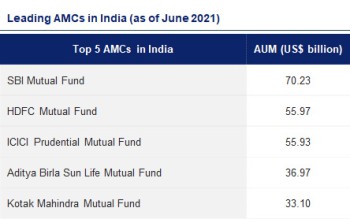INTRODUCTION
India has a diversified financial sector undergoing rapid expansion, both in terms of strong growth of existing financial services firms and new entities entering the market. The sector comprises commercial banks, insurance companies, non-banking financial companies, co-operatives, pension funds, mutual funds and other smaller financial entities. The banking regulator has allowed new entities such as payment banks to be created recently, thereby adding to the type of entities operating in the sector. However, financial sector in India is predominantly a banking sector with commercial banks accounting for more than 64% of the total assets held by the financial system.
The Government of India has introduced several reforms to liberalise, regulate and enhance this industry. The Government and Reserve Bank of India (RBI) have taken various measures to facilitate easy access to finance for Micro, Small and Medium Enterprises (MSMEs). These measures include launching Credit Guarantee Fund Scheme for MSMEs, issuing guideline to banks regarding collateral requirements and setting up a Micro Units Development and Refinance Agency (MUDRA). With a combined push by Government and private sector, India is undoubtedly one of the world’s most vibrant capital markets.

MARKET SIZE

As of January 2022, AUM managed by the mutual funds industry stood at Rs. 38.89 trillion (US$ 518.15 billion) and the total number of accounts stood at 123.1 million.
Inflow in India's mutual fund schemes via systematic investment plan (SIP) increased by 17% to Rs. 1.05 lakh crore (US$ 13.98 billion) in November 2021 as compared to November 2020. Equity mutual funds registered a net inflow of Rs. 22.16 trillion (US$ 294.15 billion) by end of December 2021.
Another crucial component of India’s financial industry is the insurance industry. Insurance industry has been expanding at a fast pace. The total first-year premium of life insurance companies reached US$ 37.1 billion in FY21. In FY22*, premiums from new businesses of life insurance companies in India stood at US$ 17.6 billion. In the first 10 months of FY22, Non-life insurance sector premiums reached at Rs. 1.82 lakh crore (US$ 24.18 billion).
Furthermore, India’s leading bourse, Bombay Stock Exchange (BSE), will set up a joint venture with Ebix Inc to build a robust insurance distribution network in the country through a new distribution exchange platform. In FY21, US$ 4.25 billion was raised across 55 initial public offerings (IPOs). The number of companies listed on the NSE increased from 135 in 1995 to 1,920 by December 2021.
According to the statistics by the Futures Industry Association (FIA), a derivatives trade association, the National Stock Exchange of India Ltd. (NSE) emerged as the world’s largest derivatives exchange in 2020 in terms number of contracts traded. NSE was ranked 4th worldwide in cash equities by number of trades as per the statistics maintained by the World Federation of Exchanges (WFE) for CY2020.
India is expected to have 6.11 lakh HNWIs in 2025.
INVESTMENTS
- India’s PE/VC investment were at US$ 77 billion in 2021, which was 62% higher than 2020.
- In 2021, Prosus acquired Indian payments gaint BillDesk for US$ 4.7 billion.
- In September 2021, eight Indian banks announced that they are rolling out—or about to roll out—a system called ‘Account Aggregator’ to enable consumers to consolidate all their financial data in one place.
- In September 2021, Piramal Group concluded a payment of Rs. 34,250 crore (US$ 4.7 billion) to acquire Dewan Housing Finance Corporation (DHFL).
- Digital payment platforms for rural India:
- In July, Dvara Kshetriya Gramin Financial Services Pvt Ltd., an NBFC operating in remote rural areas of India, acquired ‘TransactNow’ digital platform, an early phase tech start-up that provides digital financial services to India's unbanked and underserved population.
- In August 2021, Neokred, an open banking stack that delivers curated versions of issuance in the payment ecosystem, teamed with Virenxia, a provider of integrated and sustainable solutions for rural transformation and development, to launch the ‘The Kisan Card,' a special payment card for Indian farmers.
- In May 2021, the Reserve Bank of India (RBI) granted authorisation to Eroute Technologies to operate as a prepaid payment instruments (PPI) company.
- In February 2021, the Reserve Bank of India (RBI) cleared the Rs. 34,250 crore (US$ 4.7 billion) acquisition of Dewan Housing Finance Corporation (DHFL) by the Piramal Group.
- In January 2021, Sundaram Asset Management Company announced the acquisition of Principal Asset Management for Rs. 338.53 crore (US$ 46.78 million).
- In January 2021, the National Stock Exchange (NSE) launched derivatives on the Nifty Financial Service Index. This service index is likely to provide institutions and retail investors more flexibility to manage their finances.
- In September 2021, Unified Payments Interface (UPI) recorded 3.65 billion transactions worth Rs. 6.5 trillion (US$ 86.63 billion).
- The number of transactions through immediate payment service (IMPS) reached 384.88 million (by volume) and amounted to Rs. 3.18 trillion (US$ 43.19 billion) in September 2021.
- In August 2021, Unified Payments Interface (UPI) recorded 3.55 billion transactions worth Rs. 6.39 lakh crore (US$ 86.00 billion).
- The number of transactions through immediate payment service (IMPS) reached 377.94 million (by volume) and amounted to Rs. 3.18 trillion (US$ 42.85 billion) in August 2021.
GOVERNMENT INITIATIVES
- In September 2021, the international branch of the National Payments Corporation of India (NPCI), NPCI International Payments (NIPL), has teamed with Liquid Group, a cross-border digital payments provider, to enable QR-based UPI payments to be accepted in 10 countries in north and southeast Asia.
- On September 30, 2021, the Reserve Bank of India communicated that the applicable average base rate to be charged by non-banking financial company - micro finance institutions (NBFC-MFIs) to their borrowers for the quarter beginning October 1, 2021, will be 7.95%.
- On September 30, 2021, the IFSC Authority constituted an expert committee to recommend approach towards development of sustainable finance hub and provide road map for the same.
- In August 2021, Prime Minister Mr. Narendra Modi launched e-RUPI, a person and purpose-specific digital payment solution. e-RUPI is a QR code or SMS string-based e-voucher that is sent to the beneficiary’s cell phone. Users of this one-time payment mechanism will be able to redeem the voucher at the service provider without the usage of a card, digital payments app, or internet banking access.
- In July 2021, Rajya Sabha approved the Factoring Regulation (Amendment) Bill in 2020, enabling ~9,000 NBFCs to participate in the factoring market. The bill also gives the central bank the authority to establish guidelines for improved oversight of the US$ 6 billion factoring sector.
- In July 2021, India's largest commodities derivatives exchange, Multi Commodity Exchange of India Ltd., and European Energy Exchange AG (EEX) signed a memorandum of understanding (MOU) with the goal of knowledge sharing and expertise exchange on electricity derivative products. This MoU will make it easier for the two exchanges to collaborate in areas including knowledge sharing, education and training, and event planning in the field of electricity derivatives.
- The government has approved 100% FDI for insurance intermediaries and increased FDI limit in the insurance sector to 74% from 49% under the Union Budget 2021-22.
- In January 2021, the Central Board of Direct Taxes launched an automated e-portal on the e-filing website of the department to process and receive complaints of tax evasion, foreign undisclosed assests and register complaints against ‘Benami’ properties.
ROAD AHEAD
- India is expected to be the fourth largest private wealth market globally by 2028.
- India’s insurance industry has huge growth potential. India’s insurance market is expected to reach US$ 250 billion by 2025. It also offers an opportunity of US$ 78 billion of additional life insurance premiums from 2020-30.
- India is today one of the most vibrant global economies on the back of robust banking and insurance sectors. The relaxation of foreign investment rules has received a positive response from the insurance sector, with many companies announcing plans to increase their stakes in joint ventures with Indian companies. Over the coming quarters, there could be a series of joint venture deals between global insurance giants and local players.
- The Association of Mutual Funds in India (AMFI) is targeting nearly five-fold growth in AUM to Rs. 95 lakh crore (US$ 1.47 trillion) and more than three times growth in investor accounts to 130 million by 2025.
- India's mobile wallet industry is estimated to grow at a Compound Annual Growth Rate (CAGR) of 150% to reach US$ 4.4 billion by 2022, while mobile wallet transactions will touch Rs. 32 trillion (USD$ 492.6 billion) during the same period.
Note: Conversion rate used for September 2021 is Rs. 1 = US$ 0.01371
References:Media Reports, Press Releases, IRDAI, General Insurance Council, Reserve Bank of India, Union Budget 2021 22
Disclaimer: This information has been collected through secondary research and IBEF is not responsible for any errors in the same.

Turnover on NSE (Capital markets segment) in US$ billions

Industry Contacts
- Ministry of Finance
- Securities and Exchange Board of India (SEBI)
- Insurance Regulatory and Development Authority (IRDA)
- Reserve bank of India (RBI)
- Association of Mutual Funds In India
- Institute for Development and Research in Banking Technology
- India Banks Association